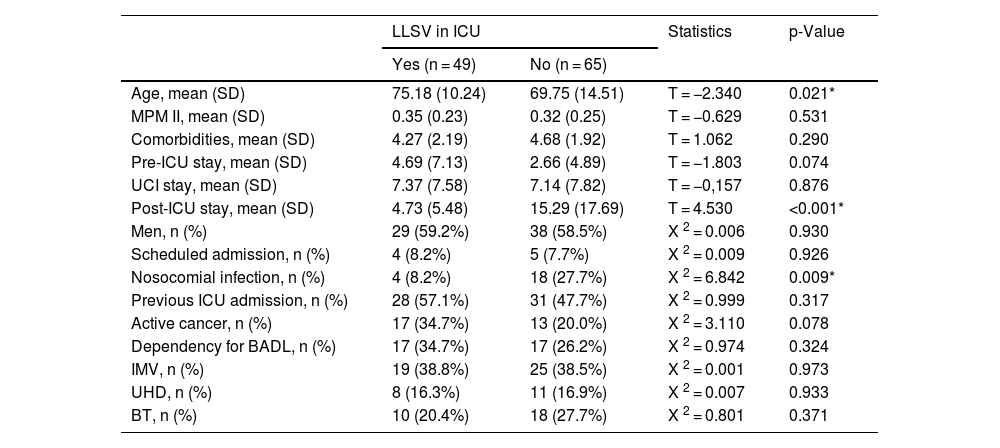Life-sustaining treatment limitation (LSV) is the medical act of withdrawing or not initiating measures that are considered futile in a patient's specific situation. LSV in critically ill patients remains a difficult topic to study, due to the multitude of factors that condition it.
ObjectiveTo determine factors related to LSV in ICU in cases of post-ICU in-hospital mortality, as well as factors associated with survival after discharge from ICU.
DesignRetrospective longitudinal study.
AmbitIntensive care unit of a tertiary hospital.
PatientsPeople who died in the hospitalization ward after ICU treatment between January 2014 and December 2019.
InterventionsNone. This is an observational study.
Variables of interestAge, sex, probability of death, type of admission, LSV in ICU, oncological disease, dependence, invasive mechanical ventilation, emergency hemodialysis, transfusion of blood products, nosocomial infection (NI), pre-ICU, intra-ICU and post-ICU stays.
ResultsOf 114 patients who died outside the ICU, 49 had LSV registered in the ICU (42.98%). Age and stay prior to ICU admission were positively associated with LSV (OR 1,03 and 1,08, respectively). Patients without LSV had a higher post-ICU stay, while it was lower for male patients.
ConclusionsOur results support that LSV established within the ICU can avoid complications commonly associated with unnecessary prolongation of stay, such as NI.
La limitación del tratamiento de soporte vital (LSV) es el acto médico de retirar o no iniciar medidas que se consideren fútiles en la situación concreta de un paciente. La LSV en pacientes críticos sigue siendo un tema difícil de estudiar, debido a la multitud de factores que la condicionan.
ObjetivoDeterminar los factores relacionados con la LSV en UCI en casos de mortalidad hospitalaria post-UCI, así como los factores asociados a los días de supervivencia tras el alta de UCI.
DiseñoEstudio longitudinal retrospectivo.
ÁmbitoUnidad de cuidados intensivos de un hospital terciario.
PacientesPersonas fallecidas en sala de hospitalización tras tratamiento en UCI entre enero de 2014 y diciembre de 2019.
IntervencionesNo existen. Se trata de un estudio observacional.
Variables de interésEdad, sexo, probabilidad de muerte, tipo de ingreso, LSV en UCI, enfermedad oncológica, dependencia, ventilación mecánica invasiva y hemodiálisis de urgencia, transfusión de hemoderivados, infección nosocomial (IN), estancias pre-UCI, intra-UCI y post-UCI.
ResultadosDe 114 pacientes fallecidos fuera de la UCI, 49 tenían registrada LSV en UCI (42,98%). La edad y la estancia previa al ingreso en UCI se asociaron positivamente a LSV (OR 1,03 y 1,08, respectivamente) y la IN, negativamente (OR 0,19). Los pacientes sin LSV presentaron una estancia post-UCI más alta, mientras que en los pacientes varones fue menor.
ConclusionesNuestros resultados apoyan que la LSV instaurada dentro de UCI puede relacionarse con un menor número de complicaciones comúnmente asociadas a la prolongación innecesaria de la estancia, como la IN.










